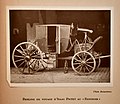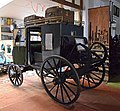Category:Berline carriages
Jump to navigation
Jump to search
type of covered, fast and light, four-wheeled, travelling horse carriage with two interior seats and a separate hooded rear seat for a footman, detached from the body | |||||
| Upload media | |||||
| Subclass of |
| ||||
|---|---|---|---|---|---|
| Named after | |||||
| Has use | |||||
| Has part(s) | |||||
| Maximum capacity |
| ||||
| |||||

A Berlin carriage is so-named because of its form of undercarriage. It has two perches linking its four wheels in place of one perch. Any body it may carry is suspended from thoroughbraces which stretch between transoms instead of from high posts. The bottom of the body is rounded to fit the thoroughbraces.
- A perch is a centre pole connecting the front and rear axles which allows the whole structure to flex
- A thoroughbrace is any of a number of strong leather straps supporting the body of a coach or carriage
- A coach has a fixed roof — "a standing roof on four corner pillars, four door pillars and full upper and lower panels". A "glass coach" has glazed upper panels
It is believed to have been invented in Germany about 1660
Subcategories
This category has the following 9 subcategories, out of 9 total.
Media in category "Berline carriages"
The following 16 files are in this category, out of 16 total.
-
Berline als Skizze in Seitenansicht.svg 1,400 × 600; 505 KB
-
Berline carriage (Moscow history museum) by shakko.jpg 828 × 632; 536 KB
-
Berline Carriage Being Pulled by 2 Horses.png 2,000 × 857; 279 KB
-
Berline d'Isaac Pictet.jpg 3,695 × 3,217; 3.21 MB
-
Carriage Berlin in the Pořežany museum.jpg 3,653 × 4,001; 3.98 MB
-
Carriage in the Pořežany museum 01.jpg 4,091 × 3,791; 3.64 MB
-
Herrschaftliche Kutsche.JPG 1,098 × 664; 145 KB
-
PM 156318 B Freyr.jpg 600 × 400; 312 KB
-
Royal Berline.JPG 2,592 × 1,944; 1.03 MB
-
Royal Carriage; collection of Leopold II.JPG 2,592 × 1,944; 845 KB
-
Łańcut Palace - parowozownia 02.JPG 3,072 × 2,304; 2.69 MB
-
Череповец, усадьба Гальских, карета.jpg 8,000 × 6,000; 16.39 MB
















